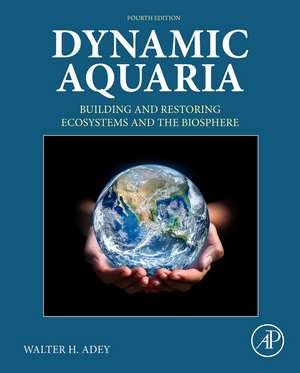Dynamic Aquaria: Building and Restoring Ecosystems and the Biosphere
Autor Walter H. Adeyen Limba Engleză Hardback – 18 mar 2024
The book also features new information on marine calcification, research microcosms, thermogeography, and methods of water movement for minimizing plankton loss. It supports a deeper biological and ecological intelligence among the human population to better understand the processes behind environmental issues.
- Offers the basic physical and chemical background necessary for understanding aquatic and marine ecosystems
- Expands available electro-mechanical tools for developing living system models
- Features new information on the biomimicry water control system, Algal Turf Scrubbing (ATS)
- Evidences how ecosystem modeling can contribute to the understanding of climate change
Preț: 690.10 lei
Preț vechi: 927.26 lei
-26% Nou
Puncte Express: 1035
Preț estimativ în valută:
132.07€ • 137.70$ • 109.76£
132.07€ • 137.70$ • 109.76£
Carte tipărită la comandă
Livrare economică 13-27 martie
Livrare express 13-19 februarie pentru 108.96 lei
Preluare comenzi: 021 569.72.76
Specificații
ISBN-13: 9780443154188
ISBN-10: 044315418X
Pagini: 532
Dimensiuni: 216 x 276 x 31 mm
Greutate: 1.51 kg
Ediția:4
Editura: ELSEVIER SCIENCE
ISBN-10: 044315418X
Pagini: 532
Dimensiuni: 216 x 276 x 31 mm
Greutate: 1.51 kg
Ediția:4
Editura: ELSEVIER SCIENCE
Cuprins
1. Introduction
Part I: Physical Environment
2. Physical Parameters and Energy State
3. Substrate - Controlling the Benthic Component
4. Water Composition - Management of Salinity, Hardness, and Evaporation
5. The Input of Solar Energy - Lighting and New Possibilities
6. The Input of Organic Energy - Particulates and Feeding
Part II: Biochemical Environment
7. Metabolism – Respiration, Photosynthesis, and Biological Loading
8. Organisms and Gas Exchange – Oxygen, Carbon Dioxide, pH, and Alkalinity
9. Primary Nutrients – Nitrogen, Phosphorus, and Silica
10. Biomineralization and Calcification – A Key to Biosphere and Ecosystem Function
11. Control of the Biochemical Environment – 3D Potential for Algal Turf Scrubbing
Part III: Biological Structure
12. Community Structure - Biodiversity in Model Ecosystems
13. Thermogeography - The Distribution of Organisms Along Coasts
14. Trophic Structure - Ecosystems and Dynamics of Food Chains
15. Primary Producers - Bottom-Growing Plants
16. Herbivores
17. Carnivores
18. Plankton and Planktivores
19. Detritus and Detritivores
20. Symbionts and Other Feeders
Part IV: Ecological Systems in Microcosms, Mesocosms, and Aquaria
21. Models of Coral Reef Ecosystems
22. Subarctic/Boreal Microcosm - Applications of New Research
23. Estuaries - Ecosystem Modelling and Restoration
24. Freshwater Ecosystem Models
25. Research Systems in Microcosms
Part V: The Environment and Ecological Engineering
26. Organisms and Natural Products
27. Large Scale Water Quality Management with Solar Energy Capture
Part VI: Synthesis
28. Microcosms, Mesocosms, and Macrocosms – Building and Restoring Ecosystems and the Biosphere
Part I: Physical Environment
2. Physical Parameters and Energy State
3. Substrate - Controlling the Benthic Component
4. Water Composition - Management of Salinity, Hardness, and Evaporation
5. The Input of Solar Energy - Lighting and New Possibilities
6. The Input of Organic Energy - Particulates and Feeding
Part II: Biochemical Environment
7. Metabolism – Respiration, Photosynthesis, and Biological Loading
8. Organisms and Gas Exchange – Oxygen, Carbon Dioxide, pH, and Alkalinity
9. Primary Nutrients – Nitrogen, Phosphorus, and Silica
10. Biomineralization and Calcification – A Key to Biosphere and Ecosystem Function
11. Control of the Biochemical Environment – 3D Potential for Algal Turf Scrubbing
Part III: Biological Structure
12. Community Structure - Biodiversity in Model Ecosystems
13. Thermogeography - The Distribution of Organisms Along Coasts
14. Trophic Structure - Ecosystems and Dynamics of Food Chains
15. Primary Producers - Bottom-Growing Plants
16. Herbivores
17. Carnivores
18. Plankton and Planktivores
19. Detritus and Detritivores
20. Symbionts and Other Feeders
Part IV: Ecological Systems in Microcosms, Mesocosms, and Aquaria
21. Models of Coral Reef Ecosystems
22. Subarctic/Boreal Microcosm - Applications of New Research
23. Estuaries - Ecosystem Modelling and Restoration
24. Freshwater Ecosystem Models
25. Research Systems in Microcosms
Part V: The Environment and Ecological Engineering
26. Organisms and Natural Products
27. Large Scale Water Quality Management with Solar Energy Capture
Part VI: Synthesis
28. Microcosms, Mesocosms, and Macrocosms – Building and Restoring Ecosystems and the Biosphere
